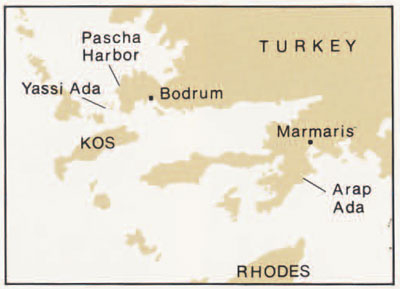
Readers of recent numbers of Expedition and the National Geographic are aware already of the University Museum’s search for two specific shipwrecks off the Turkish coast. At the risk of repetition, the project previous to the summer of 1968 may be summarized briefly.
Two bronze statues were netted during recent years by Turkish sponge draggers. One of the statues, of a Negro boy, was found near Pascha Harbor, not far from Bodrum. The other, possibly of the goddess Demeter, came up many miles away at a point near Arap Adasi in the neighborhood of Marmaris. Both were caught at depths approaching 300 feet, too deep for aqualung diving.
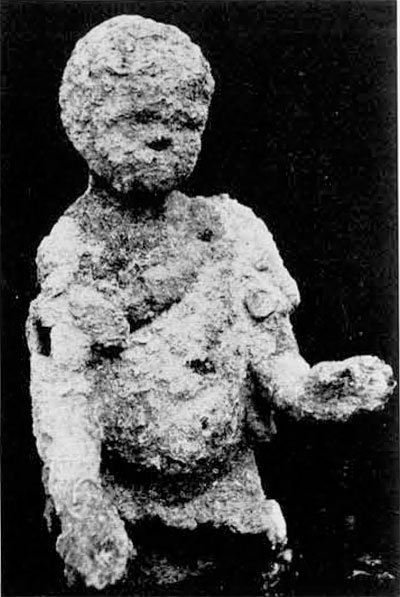
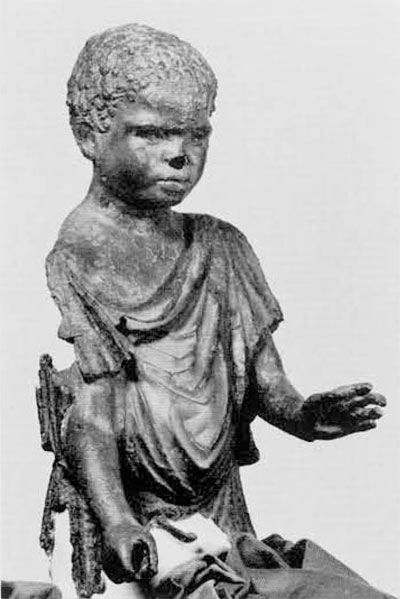
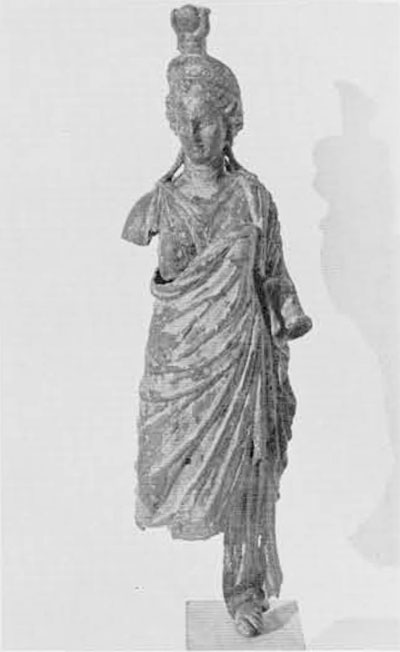
A variety of devices, including closed-circuit television, a towed observation capsule (Towvane), side-scanning sonar, and our two-man submarine Asherah, were used in the search for these wrecks in 1965 and 1967. In 1967 sonar provided a target in the area where the Negro boy had been found, and a subsequent dive with the Asherah revealed the large cargo of an ancient shipwreck; poor visibility prevented more than a few photographs from the Asherah, and these showed little more than amphoras. More than twenty sonar targets were recorded in the “Demeter area,” but these could not be visited by the submarine because of lack of time before the close of the campaign.
The sonar/submarine search was a milestone in underwater archaeology, but it was only a partial success. Had we found the wrecks we had sought so long, wrecks which might hold other Classical bronzes, or not?
With backing from the University Museum and the National Geographic Society, we attempted to answer this question in the summer of 1968. Our team in the field consisted of Frank Bartell, L.T. Joline, and Oktay Ercan, with the able assistance of Oguz Alpozen as commissioner from the Turkish Department of Antiquities; all were veterans of underwater campaigns at Yassi Ada; and Joline had previously directed parts of our earlier searches. Captain Mehmet Turgutekkin continued to be in charge of local logistics, and G.F. Bass, project director, visited the expedition during its organizational stages.
To lessen the complexity and cost of the operation, we decided against returning with sonar and the submarine, which would have required a larger staff and a larger expedition boat. We had transit bearings and charts from 1967, which should lead us back to the approximate position of each sonar target, and our equipment included only two transits, portable two-way radios, a camera, and a closed-circuit Hydro-Products television with electric generator. This would be sufficient to allow us to check each target for identification.
We realized in advance that a large trawler, of the type used in the sonar search, was not nearly maneuverable enough to hold steady above a possible wreck site. Oktay Ercan arranged the hire of a small sponge boat of the type used to follow the bubbles of helmeted divers as they slowly walk the sea floor. We tested the boat by seeing how closely we could circle a buoy without ramming it.
On the coast just opposite the spot where we had discovered the wreck with the submarine in 1967, Bartell and Joline placed the transits at the same stations established that summer. Then, using bearings from our earlier logs and charts, they directed the sponge boat out to that spot by radio. A buoy was dropped.
The first problem was encountered in simply trying to lower the television camera directly down onto the wreck. Wind and surface currents often moved the boat in one direction, while the camera, dangling on several hundred feet of electric cable, was moved in another direction by deeper currents. The camera did not necessarily follow repositioning of the boat above, and even fairly slow movements of the boat sometimes caused the camera and cable to lift upward far above the sea bed.
Although the concrete buoy anchor was later seen to have fallen directly on the ancient cargo, it took two hours of maneuvering to get the camera over the wreck. Then a second problem was encountered.
A mount had been designed to hold a photographic camera a fixed distance in front of the television monitor screen in the hold of the sponge boat. Thus the team, while watching the monitor and taking notes, could take a picture of the screen showing any point of interest on the wreck. Pitching and rolling of the boat, however, caused the television camera to rise up and down above the site more quickly than its focus could be adjusted. It was eventually possible to gauge just the moment when the television picture would be coming into focus, and photographs were taken during those split seconds.
Approximately two hundred photographs were taken as the camera swung over the cargo of amphoras, and over the galley area of the ship with its terracotta roof tiles, and cooking and eating ware. Sketches of such objects, seen briefly on the screen, later proved of great help in studying the photographs.
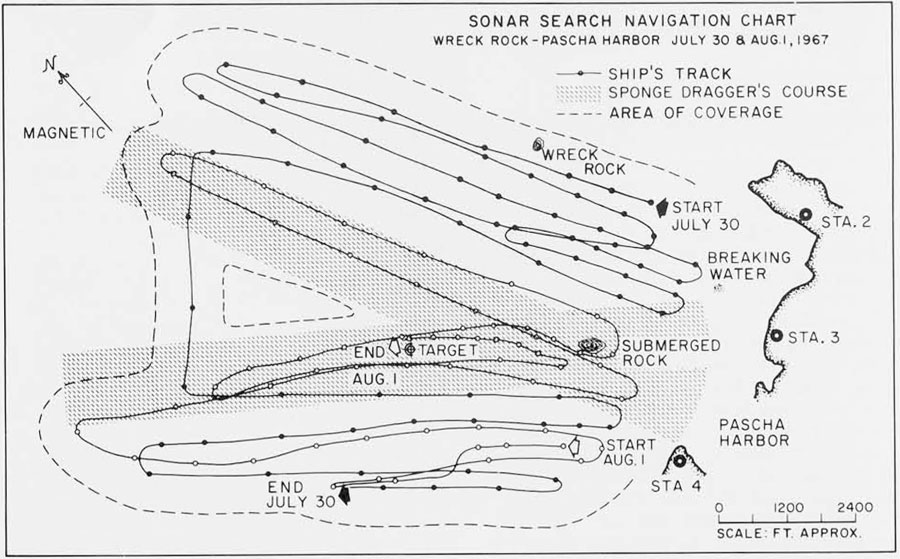
There seemed to be no other signs of bronze on the wreck. Was this just another amphora carrier which had sunk, by incredible coincidence, in the open sea just in the middle of the search area?
The question is not easily answered. Patient developing and printing of the films followed the work in the field, and the authors have spent hours in the Blair Academy darkroom studying the results. Amorphous lumps of concretion may be seen among the amphoras, and in at least one case a roughly cylindrical form. The broken leg or arm of a bronze statue? We have looked again and again at a photograph taken of the Negro boy just as he had come from the sea, before he was cleaned of concretion, and we wonder what he would have looked like half covered with sand on the sea bed. It seems doubtful that television could have distinguished his form.
A three-dimensional view, using stereophotographs, might have been helpful, but this would have required two television cameras, mounted together, and two monitors in the boat, with two photographic cameras. Perhaps, in a future year, we will use such a system.
What, then, had we accomplished during the short summer? In spite of fuzzy photographs, and in spite of dark patches of sea growth that distort the profiles of recognizable pottery, we learned that television provides a relatively simple method of obtaining at least tentative identification of deep wrecks. Table ware and amphoras must be reasonable contemporary with the sinking of a ship, and television views allow sufficient information for dating this pottery. Art objects on board may be much older than the sinking, but they cannot, of course, be more recent! Thus, although we may not be able to identify positively a deep wreck with television, we can at least rule out those wrecks of improper dates.
The dates for the Negro boy and for another small statuette netted in the same area are not contradicted by the dates of the pottery on the deep wreck. In fact, they agree so well that we now feel we have enough information to warrant sending deep divers, breathing helium and oxygen rather than plain air, down to the site for first-hand inspection. A mechanical arm attached to the Asherah, or a television-guided arm lowered from the surface might allow us to raise objects for identification, but we feel that divers can do a much more careful and scientific study.
Using the same equipment and methods described above, the team also visited the area where the Demeter had been found. Television revealed that one of the twenty-odd targets in that area was also an ancient ship, and an analysis of the photographic results will begin soon.
